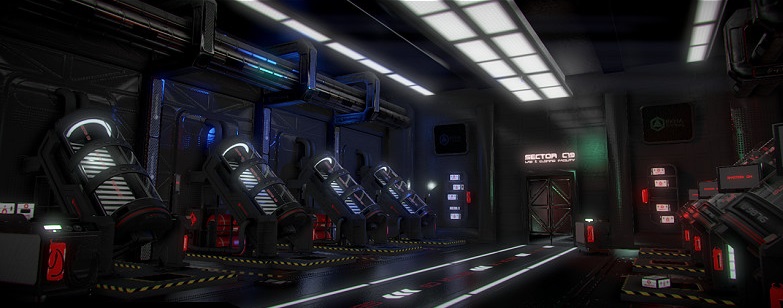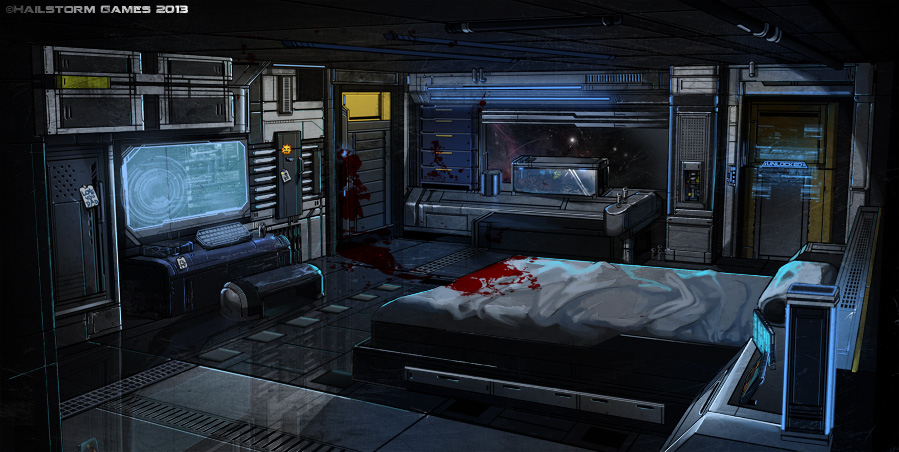Sleeper Ships
Before the development of the Singularity Drives, voyages between the stars were measured in decades - even with the use of naturally occurring wormholes to shorten the distance traveled. For example: The distance to the nearest wormhole to Earth - the Olympian Gateway - took ten years to reach at 60% c. From the exit point of the Gateway to the colony of New Eden took another five years of travel.
To avoid the problems of having a crew spending fifteen years or more on a ship - which include psychological repercussions, needs for habitation space, and systems for renewable supplies of food and water - systems of chemically induced hibernation were developed. With these methods, the crew might pass the years as if one were passing an afternoon with a short nap. Naturally, the process and physical results were much more dramatic than this entails; but the passage of felt as instantaneous as this analogy implies.
An early colony ship, circa 2165 C.E.
How It Works
Rather than having ships equipped with living facilities, food production facilities, water purification systems, etc; many early interstellar ships were designed with banks of hibernation pods where the crew and passengers could sleep out some or all of the voyage. Depending upon the purpose of the ship, these hibernation bays could be a small part of the design or a primary focus - such as with a colony ship.
The procedure of inducing hibernation in the occupants of the bay used - and still uses - technology that has been available since the 20th century C.E. A cocktail of drugs are introduced to the occupant inducing a deep sleep similar to a coma. As long as a steady infusion of the chemicals is maintained, the comatose state can be maintained indefinitely.
Practical Limitations and Procedures
Medical Ramifications
Of course, one does not put a patient into a chemically induced coma for over ten years without raising some concerns regarding their health after they wake up. The body continues to age during this time, although at a decreased rate due to the lowered metabolic rates. A passenger on a fifteen-year voyage will still age fifteen years, although gently. Another primary concern is muscle atrophy. Electrical impulse leads must be attached all over the body before hibernation so that the muscles can be stimulated during the voyage.
This minor stimulation prevents complete atrophy, although the subject will still awaken with a greatly diminished level of physical fitness. Several methods have been devised to counteract this issue, including waking up the subjects periodically for months at a time to engage in rigorous exercise routines. Another benefit of this type of rotation is that the crew of a ship might be bolstered from time to time to undertake major maintenance projects. In the case of passenger vessels - such as colony ships - the passengers were usually awoken about a month prior to arrival at their destination to re-acclimate their bodies to physical use.
Crewing the Ships
Normally the crew would operate on a rotation schedule, where a handful of them would operate the ship's systems and perform maintenance for a limited tour of duty before being relieved. They would then enter hibernation pods for the remainder of the journey. Depending upon the length of the voyage, this tour of duty would normally be between three months and two years. It was found that longer-duration tours led to negative psychological ramifications, so shorter duration duty-rotations became a preferable method. A six-month rotation is still standard on many trading vessels that utilize natural wormhole routes instead of Singularity Drives.
After determining that the loss of the freighter Valencia resulted from deliberate crew sabotage following an extended duty rotation, it is the decision of the board that all future rotations be limited to a term of no more than six months.Excerpt of an internal memo from the Transtar Corp. board of directors - dated September 18th, 2184.
The total complement of a sleeper ship's crew and the size of each duty rotation would depend upon several factors, including but not limited to the size of the ship and the level of on-board automation. Many contemporary freighters that still use these travel methods can be operated by ten personnel at a time. Thus, such a ship on a ten-year journey would require a total crew complement of at least two hundred individuals if observing the standard six-month duty rotation.
Discovery
Following the invention and implementation of the Fusion Drive (more information coming soon) in 2153, travel throughout the Sol system became a reality. However, interstellar travel was still a looming challenge due to the time required to journey the extreme interstellar distances. When the first expeditions to nearby systems showing evidence of habitable exoplanets were proposed, the first order of business was to determine a way to get the crew there without going insane or running out of supplies on a journey that could take decades.
Captain's Quarters by Hailstorm Games
The first use of a sleeper ship was the UNS Icarus, which launched on July 9th, 2165 - bound for Proxima Centauri B. The Icarus made its ten-year journey without incident utilizing a crew-rotation method for vital ship operations. A complement of 200 scientists, military personnel, and colony volunteers were also on board; but were not awoken until two weeks before arrival at their destination. While the small colony founded on Proxima Centauri B - later dubbed Proximus would remain an important scientific and trade outpost, the planet would not prove favorable for major colonization efforts.
Modern Applications
With the advent of Faster Than Light Travel using Singularity Drives, the prevalence of sleeper ships has been greatly diminished in the last two-hundred years. While many ships still utilize the natural wormhole routes and must rely upon this technology to deal with long travel times, most interstellar shipping is handled by large corporations who specialize in transporting cargo with jump-capable ships. Most larger naval forces also rely upon the Singularity Drive to move their assets around more efficiently.
Even with these technological advantages, crews may have to spent weeks or months in transit from their jump-points to their actual destination - or from their origin to a safe jump-point. Some slower vessels still utilize hibernation technology to help ration supplies and reduce the psychological effects of spending months in transit. However, the practice of spending years in hibernation is almost unheard of in modern times.
The Cryo-Stasis Alternative
An alternative to chemically-induced hibernation developed shortly after was the use of cryogenic stasis. The main advantage of this technology was that placing passengers and/or crew in a stasis state halted the aging process. Rather than arriving at their destination ten or twenty years older, the individual in question would be in the same physical condition as they were when they embarked on the journey. Certain chemical treatments had to be developed to prevent cellular damage during the freezing process, and the unfreezing process could take a week or more.
A cryo-pod bay in an early colony ship.
Unfortunately for many people who embarked upon these cryo-sleep voyages, the injury and fatality rates from the cryogenic freezing process was much higher than with chemically-induced hibernation. While the risk of death from hibernation has always been similar to undergoing minor surgery, the fatality rates from cryogenic stasis has never fallen below ten percent. As a result, cryo-stasis was a short-lived alternative that very rarely sees use in contemporary vessels.
Remove these ads. Join the Worldbuilders Guild














Comments